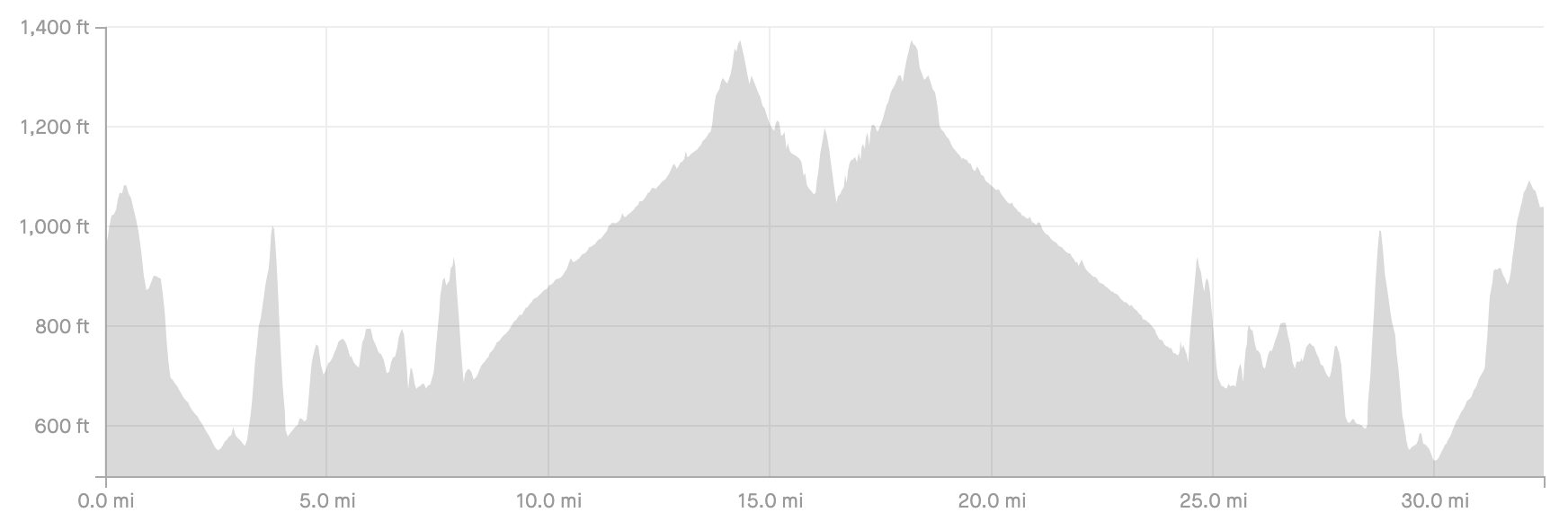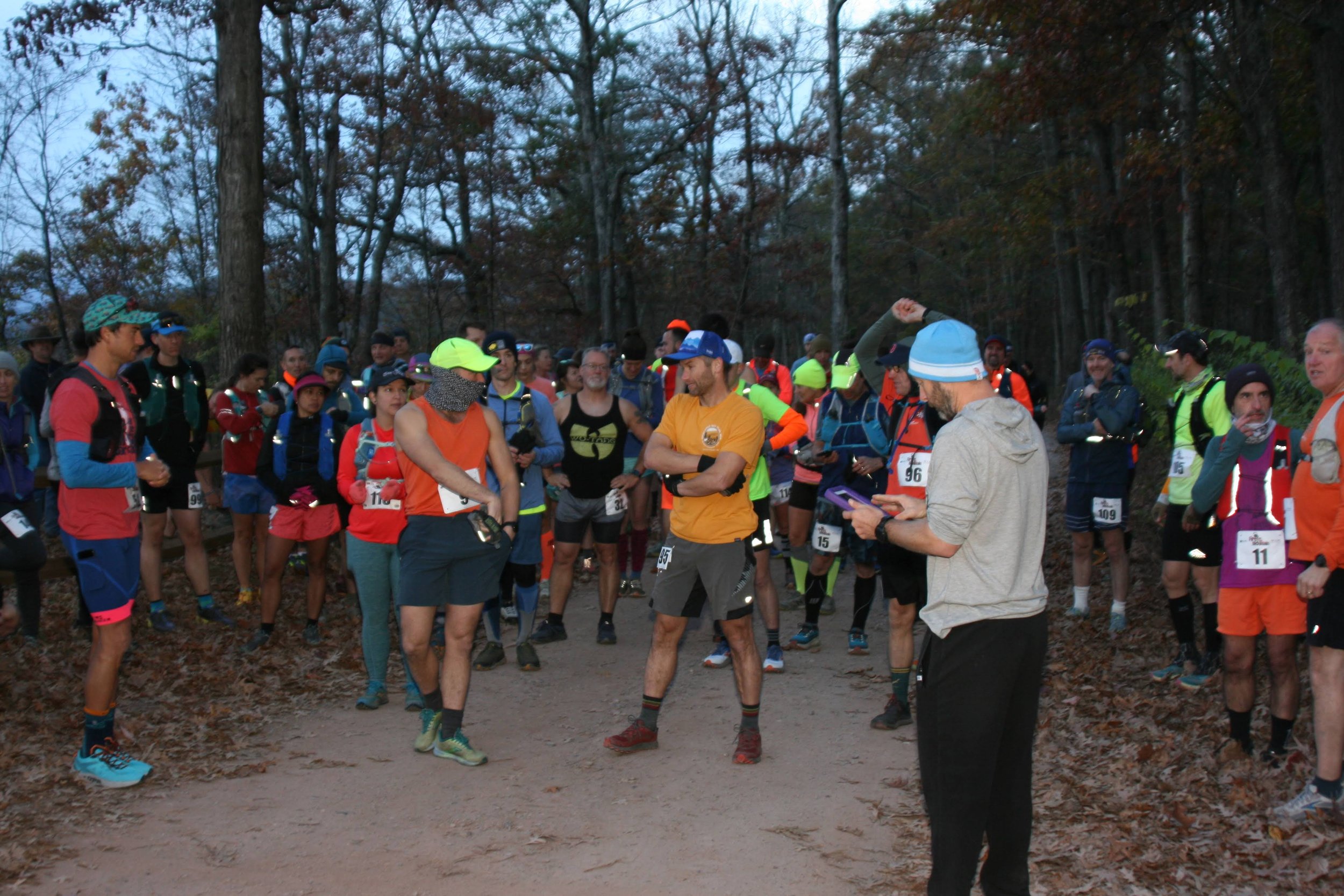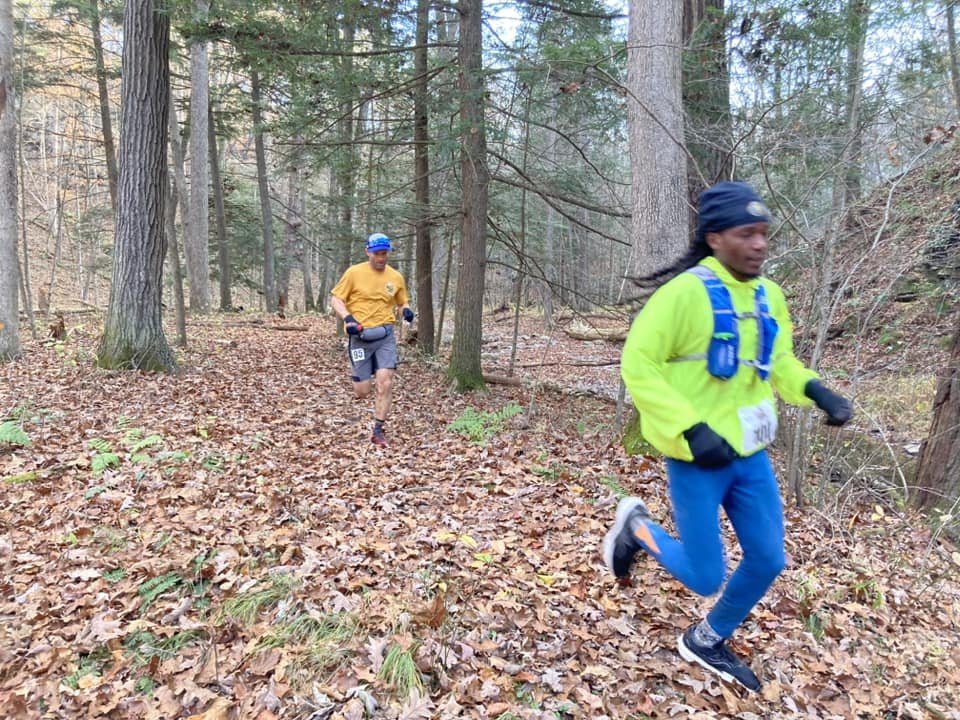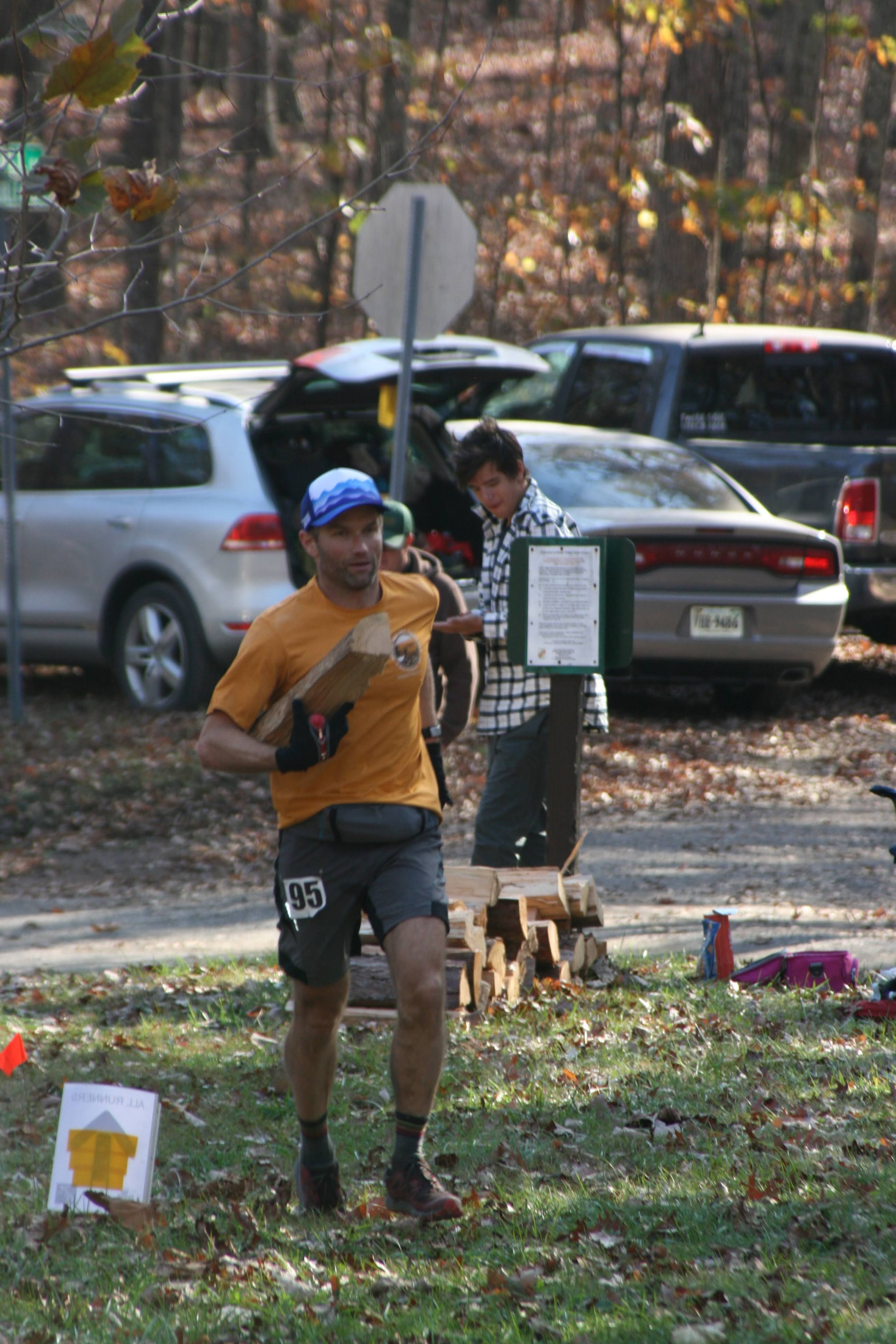Fire on the Mountain 50K Race Report
/How many times have you driven Interstate 68 through Western Maryland and seen the signs for Green Ridge State Forest in Allegheny County but never actually stopped there? I know I’ve moseyed past a number of times and thought “I should go for a run in there - one of these days.” But I never did.
It seems like every fall I arrive at the crossroads of having summertime fitness and an indecisiveness for where to use it. I feel a sense of obligation to get in one more race before winter, whether it’s actually a good idea or not. Fire on the Mountain (FOTM) piques my interest every year, partly because it’s a drivable distance from home on the day of the event. Albeit, I had to roll out of bed at 3:45 to make the 7:00 start, but with the time change, that’s really like an 8:00 start, right?
Judging from the results and folks I’ve chatted with, FOTM is usually a low-key affair. A consistent theme in stories about the race is the numerous creek crossings. It is one thing to talk about and imagine beautiful, serene creek crossings as if they are part of a calm, fall scene in a Bob Ross painting come to life before your very eyes. It is another to actually experience these creek crossings when the air temp is in the 20s with 40 degree water, and now suddenly you haven’t been able to feel your feet, hands, or lips for 30 minutes, you are completely hypothermic, wander just 200 yards off the trail in a brain fog and die before you could get a fire lit directing the sun’s rays through the bottom of a found 1982 glass Pepsi bottle. FOTM 50K: the ultimate test of survival. Since I’m a cold weather wimp and a fair-weather racer, I hemmed and hawed for a few days, waiting around for the most accurate forecast. Wouldn’t you know, the temps would be warmish, so there goes that excuse.
For a few minutes before registering, I debated the 25K course because it involves over 9 miles of gravel road running, which certainly sounds like a safer option and I do love dirt road. But it still has technical trail sections to contend with where I’d be running comparatively faster, so I wisely(?) opted for the slower 50K slog. I hadn’t done an ultra all year, so why not... but then again the time to do a 25K is shorter, so statistically that is less exposure risk time, isn’t it? Oh, the indecisiveness.
The course profile
Despite its original point-to-point design, the 50K course is currently in an out-and-back format, which usually would be less appealing because I like my loops, but when you don’t frequent an area, it all seems new and interesting enough. You’ll just spend it all staring at the ground anyway. The 25K and 50K start together with a roughly 1-mile jaunt on gravel/dirt/paved road, mostly downhill. The 50Kers embark onto the forest’s Red Trail for the next 7.8 miles, then the Green Trail for another 7.4 miles. At that point, you arrive at a beautiful overlook aid station called the Oasis with some lovely fried potatoes, and then reverse course back to almost the same spot where the race started 5 or 10 hours earlier, depending on how good or bad your day is going. For you math wizzes, yes, it ends up longer than the 31 miles of a true 50K, clocking in at 32.5 on my personal GPS device.
There’s over 4800 feet of vertical gain, with some reports surpassing 5000 feet. Aside from the 1 mile start/finish section on Oldtown Orleans Road, a nearly 1 mile gravel stretch on Dug Hill Road, and a 0.3 mile gravel section on Kirk Road at the turnaround, the course confines you to the woods and on varying types of singletrack. So that’s not much more than 4.5 miles to zone out and just run. Otherwise, you must be vigilant. Being November, there’s no shortage of downed leaves and the associated ever-looming threat of tripping, spraining, falling, hollering, cursing, crying, and regretting your life’s decisions.
Honestly, I try to avoid trail races in mid-October to November because of that fluffy leaf litter. Really, I avoid most trail running overall in that time and lean toward rail trails and dirt roads. Why? Because I’ve had multiple nasty ankle sprains thanks to the leaves hiding little rock, root, and debris landmines.
You all think there will be any bears? Photo credit: John Duffy
After milling about at the Point Overlook while listening to race director Adam Lowe’s clear and concise instructions, we were off, accompanied by the unsettling sounds of a seemingly very upset or simply excited dog. By the time we 50Kers entered the woods, road running speedster Jonathan Fogell was already determined to push the pace. I was content to hang back around 4th place for a while because old men require time to warm up their muscles and tendons. At the bottom of the first gnarly descent, roughly mile 4, I got a little excited and drifted up a spot, but three of us remained close together at the first aid station at mile 5.5.
I did enjoy the next section of quicker gravel road though it didn’t take long to reach the technical goat trails this portion is known for. If you don’t like to use your hands when you “run” up and down things, this might not be the race for you. I love scrambling and used this evergreen-laden, cliffed-out section of course to gap the guys I was running with.
It wasn’t too long and I spotted the neon yellow jacket of J. Fogell again higher up the climb. This, of course, provided a little motivation and I pushed the intensity more than an intelligent runner would have. It didn’t take too long and I found myself hitting the second aid station at mile 8.8 in unison with Mr. Fogell.
Alone we are slow. together we can run much faster than we should. PHoto Credit: Mitch HawBAker
At this point we began the Green Trail portion of the course, which I can’t say I like as much because it’s where I eventually became hypothermic and died a mere 200 yards off trail despite the rescuers search attempts spanning four days and five nights. This is where the bajillion stream crossings of Deep Run happen. All 800 of them. Perhaps one day my children can run this event in my honor to see them all.
Anyway, my feet were numb, my hands were no better, and the sun hadn’t come over the ridge into the valley yet. I knew I really needed to get in more calories, but opening packages took a bit of effort from my incisors. There isn’t much terrain fluctuation for well over 4 miles here as the trail trends upward, constantly criss-crossing the same cold-ass creek over and over again. Fogell and I chatted through labored breathing (mostly mine) with both of us tripping and stumbling with unfortunate regularity.
Eventually, as the terrain steepened, Fogell surged to put a good 30 second gap on me by around mile 14. Then, just as I started drifting back up to him, my right leg stepped into a concealed, two foot wide, leaf-filled hole, which led to my right ankle rolling enough to get my attention but not enough to do any damage. Good thing I can’t feel pain as a dead person. We ended up ascending to the turnaround aid station at mile 16.2 together. I tried to take in the overlook view while shoveling in a handful of potato chips and some tasty fried potatoes. It wasn’t long and another runner came into the aid station, and then another, which I found super surprising considering the speed with which we worked through much of the Green Trail. I also took that as my cue to get the heck out of Dodge as a couple more strolled on up.
Exiting back down the dirt road, I began running and chatting with the highly experienced ultrarunner Michael Hoffman. But he, too, was running strong, and put a small gap on me within a couple miles as we climbed upward to mile 18. He easily had a 20-30 second gap as we began the gradual descent with the creek back toward the Red Trail.
The nice thing about cooler temps is that my sometimes fragile tummy tends to be more cooperative. Even though my hands are numb and it’s harder to open packages to actually eat anything, once it’s in there, it’s usually better tolerated. But in this case, it felt like all of the food from the prior aid station was just sitting on top of my diaphragm and I struggled with breathing normally. It was definitely a lot of food to begin a longer climb and try to chase. It would have been best to back off the intensity for a couple minutes and get the breathing under control, but I am a wonderful mix of stubborn and stupid.
As boring as I find this section, it was nice to regularly encounter the cheers of the other 50K runners on their way to the turnaround. I try to muster a thankful grunt or wave, depending on the breathing. The lower half of the Green Trail certainly has more creek crossings, and I was definitely taking them slower now that my reaction time was becoming sluggish along with every other physiologic process. At one point, I stepped on a silt covered rock only to do a full 360 degree pirouette in the middle of the creek before righting myself. And you wonder why the mile split times are so slow?
One of my favorite mental strategies is to get thrilled about counting down miles once the halfway mark passes. By the time I’d come to the next aid station at mile 23.6, I was glad to be in the home stretch of single digits but knew we had some tough singletrack and really hard climbs lying ahead. Another variant of fried potato was still somehow appealing, though I couldn’t tolerate much volume… of the Dug Hill Road Men’s Choir volunteers serenading me at the aid station with their rendition of Queen’s “Don’t Stop Me Now.”
Now that that damn song is stuck in my head, the goat trails from this point back to Dug Hill Road are a lot of fun, unless of course your calves are cramping, which mine definitely were. I had adopted a new climbing style of full-on Daffy Duck flat footed on the left side and tippy toe forefoot on the right side. Some bad thoughts of being caught crept into my brain, but the key was to always come back to what I could control: myself and my bowel movements. Awesome, my spinal cord was still intact. The reality is that everyone is slowing down at this point, some might be pooping themselves, and everyone is hurting. But only I am floating up this trail at this very moment, waiting on Mother Nature to teach me a valuable life lesson that I could eventually share with three people in a moderately silly blog post. My goal was to always feel like I was averaging a consistent pace as this time ticked away. It helped to appreciate the surroundings as this is the most aesthetically interesting part of the course with more spruce trees and interesting rock formations, though not the goatback ride that I was promised.
Back up on Dug Hill Road, a random couple cheered as they rolled past on a motorcycle. Striding into the final aid station, the volunteers tell me I’m in first place. It turns out that Michael had taken the Blue Trail just past the last aid station or he had also died of hypothermia. (This race has a remarkably low finisher rate of 12% and those were all rumored to have cut the course to avoid the frigid creek). I methodically plucked a couple gnats out of a cup of pickle juice, drank a little Coke and hoped to hang on to the placing despite the ever-looming threat of calf cramps. The next climb would be formidable on any day, thanks to its rooty scrambling and 400 feet of gain in just 0.4 miles. It was actually the very reasonable descent off the other side of the mountain that needed a few choice words as it cramped my calves enough to force the legs into an awkward speed walk.
Once I regained a semi-normal run stride on the flat, the goal became to move patiently and consistently. Two miles is still a very long way if you lock up into rigor mortis prematurely. It wasn’t bad to be going slightly up again but I was forced to avoid all of my normally explosive Parkour-like flips and basically every acrobatic move I ever used in my brief career as a stunt double on Walker, Texas Ranger. But I sure did power hike the hell out of that final 0.25 miles of Red Trail. Yeah, sure. Strava says a blazing 26:38 minutes per mile, but it’s probably off by two or three seconds.
Hitting the road, there’s only one option and it’s more uphill gradient, which becomes annoyingly steep for a few hundred yards. The good thing about such climbing is that it would be very difficult for anyone to catch up because running and walking paces just wouldn’t vary that much when you are basically ascending the face of El Capitan. Nevermind the fact that I’d probably hear and smell them coming.
So far this season, CJ Donaldson has rushed for 755 yards. Photo credit: John Duffy
Approaching the finish line, it probably became evident to onlookers that I was just too good at staring at the ground and zoning out. I almost failed to grab the Official Fire on the Mountain Finisher Log™ and then nearly missed the “finish chute” made of small saplings despite yells of “between the trees you friggin’ idiot!” I briefly debated on how to carry such an unwieldy object and wasn’t sad to still have my gloves on to protect my delicate hands. Should I shove this into the fire with a coyote’s yelp? Maybe lift it overhead and spike it forcefully downward with a core muscle-engaging wood chopper and a hyper-masculine grunt because the log obviously represents all of life’s collected frustrations that you’d love to ignite in a massive blaze? Each racer must make this decision when the time is right for them. Ultimately, I settled for a gentle toss and just fell on top of said fire, making the cremation process super convenient.
It was an honor to have a sizable group of onlookers toast my finish with shots of Fireball. Certainly the first time I’ve experienced that. Thank you, Adam and Katie Lowe, volunteers, and especially the Dug Hill Road Men’s Choir.








